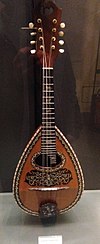Mandola
The name mandola may originate with the ancient pandura, and is also rendered as mandora,[2] the change perhaps having been due to approximation to the Italian word for "almond".Historically related instruments include the mandore, mandole, vandola (Joan Carles Amat, 1596), bandola, bandora, bandurina, pandurina and – in 16th-century Germany – the quinterne or chiterna.However, significantly different instruments have at times and places taken on the same or similar names, and the "true" mandola has been strung in several different ways.Some Irish traditional musicians, following the example of Andy Irvine, restring the tenor mandola with lighter, mandolin strings and tune it F-C-G-C (two semi-tones lower than G-D-A-D, since the mandola's fretboard is two frets longer than the mandolin's), while others (Brian McDonagh of Dervish being the best known) use alternate tunings such as D-A-E-A.Alex Lifeson, guitarist of Rush, has also featured the mandola in his work.
mandore (instrument)Mandola (disambiguation)ClassificationString instrumentpluckedHornbostel–Sachs classificationchordophonePlaying rangeRelated instrumentsMandolinOctave mandolinMandocelloMandobassBaglamasBouzoukiIrish bouzoukistringedmusical instrumentviolinC3-G3-D4-A4panduramandoramandore16th-centuryGermanyquinterneunisonplectrumtremolandofolk musicItalian folk musicIrish traditional musiccitternAndy IrvineDervishguitarAttila the StockbrokerTempestAlex Lifesonmandolin orchestrasWayback MachineHistoryNorth AmericaPlayersPlaying traditionsSociety (Peterborough)BandolaBandolinBandoraBandurriaGitternLaoutoMandolin-banjoMandoloneMandoluteMandriolaOrpharionResonator mandolinBeltonaBreedloveCollingsDel VecchioEpiphoneGianniniGibsonHarmonyHohnerIbanezMartinMichael KellyNationalNational Reso-PhonicOscar SchmidtOvationSeagullTacomaTanglewoodWeymann